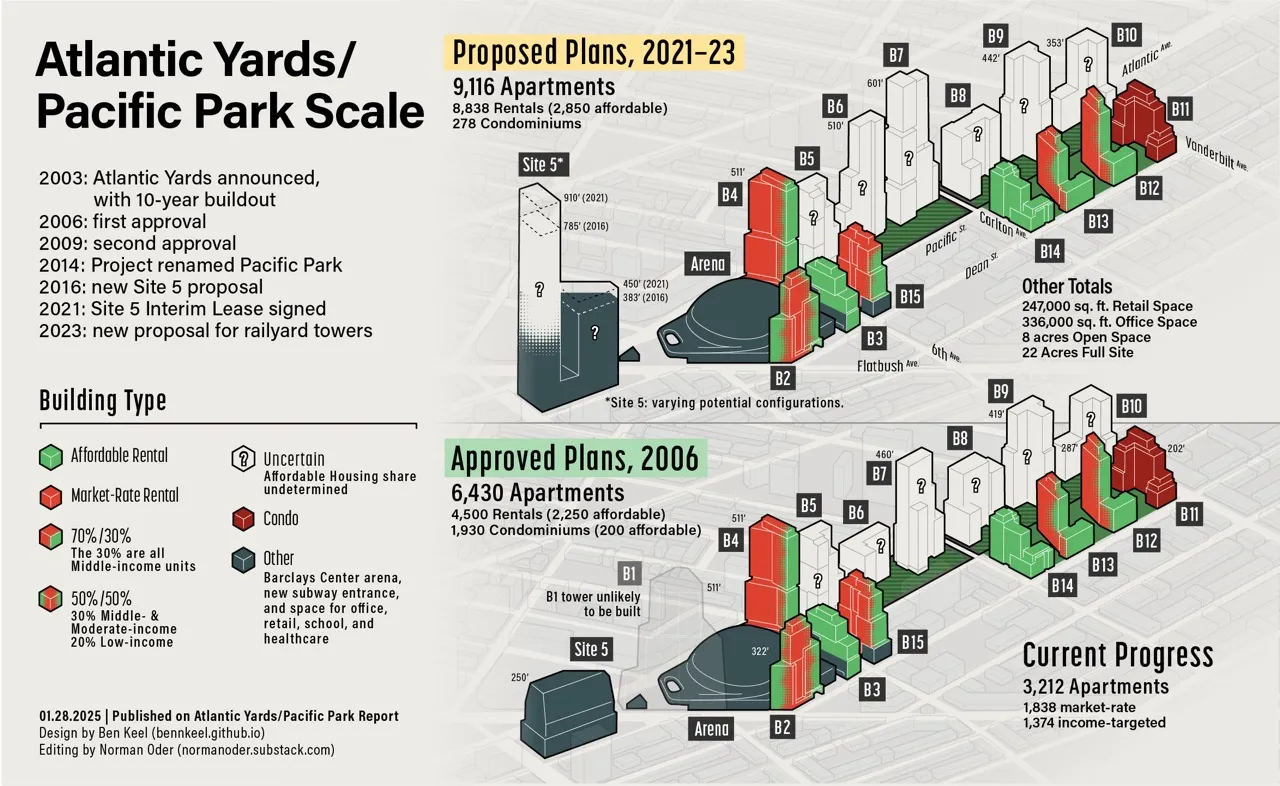(The Atlantic Yards/Pacific Park buildings visible behind Mamdani, by the way, mostly have 30% affordable units, albeit aimed at middle-income household.)
If "we should guide these changes through comprehensive planning, not a piecemeal approach," as he says, how does that comport with the professed fast track?
Mamdani plans to use "the City’s public land as a source of subsidy, with numerous opportunities to build" and upzone areas, including those cut out of Mayor Eric Adams's City of Yes plan, to allow for more capacity. That, of course, requires City Council assent.
The Atlantic Yards angle
Prospect Heights resident Sean Sullivan
observed on X/Twitter, "This was obviously shot at the site of the long delayed final portion of the Atlantic Yards / Pacific Park development (i.e. my backyard), which seems appropriate."
Indeed, Mamdani not only stood on Vanderbilt Avenue just below Atlantic Avenue, as shown in the screenshot above, he walked south down Vanderbilt into lower-scale Prospect Heights.
He said nothing about Atlantic Yards/Pacific Park, perhaps because he doesn't know much and perhaps because it's both appropriate and not.
 |
| Unofficial rendering of approved plans |
Yes, this is a site approved for six huge towers, and they qualify as "taller buildings near subway stations, upzoning wealthy neighborhoods, and eliminating... parking lots."
But they haven't been built, because the upzoning--actually, an override by New York State of city zoning--was insufficient to make it economically worthwhile, at least over multiple political and business/interest rate and subsidy/tax break cycles, as well as developers facing their own economic pressures.
Perhaps the developers overreached and the state failed to vet those plans?
The zoning override was justified by the expected cost of infrastructure--a platform to support vertical construction--as well as the inclusion of affordable units.
Though New York State allowed "affordable" to have a broad definition--participating in a government program--rather than the mix of low-, moderate-, and middle-income units promised in the 2005 Affordable Housing Memorandum of Understanding, that wasn't enough.
What now?
Now Atlantic Yards/Pacific Park is an inflection point. Could a mayor, offering additional subsidies, get the buildings built? Maybe. Would "100% affordable" work? Would it be appropriate to allot a disproportionate amount of bonding and subsidy capacity?
Does the developer--whatever
pending joint venture now might surface--deserve additional buildable square footage, which they likely will seek, perhaps based on Greenland USA's previous
proposals, gaining free bulk (land!) when earlier developers had to bid for development rights over the railyard?
 |
| Unofficial rendering of proposals |
If this is truly a public sector project, could/should New York State find a way to get the land back?
After all, the project developer, based on a 2014
settlement agreement negotiated by the coalition
BrooklynSpeaks, is supposed to pay $2,000/month for each of the 876 units not delivered by May 2025. At $21 million a year, that could add up.
Surely, however, the pending joint venture wants to renegotiate. In other words, it's complicated.
How can Mamdani's plan be financed?
First, Mamdani says he would push Albany to lift a cap on the city’s municipal bond capacity so it can secure $70 billion in municipal bonds. Those funds would come on top of the $30 billion the city has already pledged to spend on housing production, bringing its total commitment to $100 billion.
How do you plan on borrowing another $70B without exceeding the city's existing debt limit which is pegged by the price of real estate? Also, you'd be increasing the debt service by 70% with service exceeding 15% of tax revenues as required by the New York City Transitional Finance Authority."
Note that the New York City Comptroller, Brad Lander (another candidate)
suggests "the [current] debt limit does not fully reflect the City’s ability to assume and service debt to finance infrastructure," but the increase, of course, would be subject to debate.
Some
praised "Left YIMBYism," while others
warned of the tension between production and the commitment to build union and ensure the units are rent-stabilized. Others
suggested that relying on the public sector was unwise.
Here is his policy paper,
Housing By and For New York, which cites plans to "significantly expand programs that serve families with the greatest need:
 The devil, of course, is in the details. Given that "affordable" means households pay 30% of their income, what would the income range be?
The devil, of course, is in the details. Given that "affordable" means households pay 30% of their income, what would the income range be? 

Comments
Post a Comment